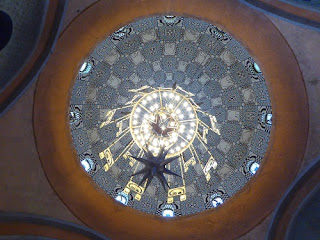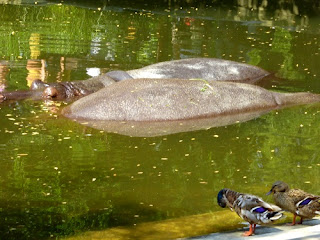Thursday, 10 August 2017
Birds, beasts and zoo buildings of Budapest
There's a happy little zoo, if such a thing isn't a contradiction in terms, in the middle of Budapest's Margaret (Margit) Island where the nesting storks are presumably free to come and go as they wish.
Finding it on a hot day's slow stroll around the lime-blossom-scented island was serendipity. But I consciously sought out the main Budapest Zoo not so much for the animals as the architecture.
This may look like a mosque but in fact it's the Elephant House, originally designed by architect and university professor Kornél Neuschloss, who was in charge of the technical works which led to the opening of the zoo roughly as we know it now in 1912. Its chequered history had begun in 1866, and in the interim attempts to liven up the public's reluctance to just come and gape at the animals included the introduction of circus acts. In vain. Only when the Municipality of Budapest took over the site in 1907 did things change for the better. In addition to Neuschloss's work, which also featured the wonderful Main Gate
topped by polar bears
and with a mandrill in the wider design,
his talented former pupils Károly Kós and Dezső Zrumeczky added other houses in various 'exotic' styles (they were influenced, of course, by Art Nouveau and the Vienna Secessionists). Most were destroyed in the Siege of Budapest, when the animal species shrank from 2,000 to 15 and the populace were reduced to eating most of them, but the buildings were handsomely reconstructed or rebuilt after 1945. Among these, I take it, are a mosque in Maghreb style surrounded by zebras and flamingos,
as well as a far eastern Reptile House
and what is now the Lemur House, in its rather splendid decadence within but still spacious.
And my first ever acquaintance with ring-tailed lemurs was actually rather marvellous.
They have the run of quite a few trees in their compound, scurrying and shrieking above a couple of well-placed seats.
The Elephant ('Pachyderm') House, though, is the design highlight, from the archways at front
and back
with a minaret to the side
and the dome splendidly decorated within
along with the corridors,
though the 'rooms' leading off the lanterned hallway are more what you might expect.
One elephant was nearly out of sight beyond the back entrance, though from there one got the best view of the hippos basking in the water to escape the heat, in the company of two unperturbed ducks.
More elephants were to be found in the huge Savannah Complex, designed in 2008 by Anthony Gall,
trunking up for their bales of grass
while a white rhino didn't look quite so happy nearby.
I was also pleased to see my first aardvark, pigging around in the dark. This isn't the greatest of photos, owing to the semi-dark, but it does offer the ocular proof of this strange creature.
As zoos go, though it isn't big, Budapest's example - now, I'm told, run by a rather visionary CEO - is green and lovely. Its south end, which used to be a funfair, is now more a botanic garden with the old iron-structured Palm House of 1912 by Gyula Végh as its centrepiece.
And the central lake, with ubiquitous pelicans, gives a further feeling of space.
My visit was a rather restricted one on the last morning of my week-long Wagnerfest visit, and I ran out of time to hunt out the rarest creatures - Komodo dragons and wombats - but I did catch passing glimpses of an African crested crane
and a not-laughing, in fact rather melancholic-looking kookaburra.
The storks were happier far in their little sanctuary on the island, and with them I take my leave of Budapest for this year.
Subscribe to:
Post Comments (Atom)

































7 comments:
Lovely post. It's been a long time since I've visited a zoo--and I'll confess to some ambivalence about the concept--but this does seem one in which the animals, birds, and such are well tended with comfortable spaces. Certainly the architecture is imaginative, as you show so well.
Zoos are still a guilty pleasure for me, rooted in childhood when I was an XYZer ('Exceptional Young Zoologist') at London Zoo. How we used to love it when Michael Boorer handed monkeys round. In those days everything looked so much bigger. Now I do find it offensive to see the big cats and primates caged, duly avoided them in Budapest. Cologne Zoo is one of the best - the animals go off for regular six-month holidays away from the prying public eye.
Newbee here
I am not a lover of zoos but this one looks rather beautiful
Greetings from north wales btw
It is surprising that there is relatively little remaining Turkish influence in Budapest - the elephant house you illustrate says that it is still alive to an extent !
A couple of ancient domed bath houses remain. But to be honest there isn't a great deal that's pre-19th century left of any denomination, so often has Budapest been trashed and razed. Even the cathedral on the Var is mostly a reconstruction. You only have to stand on a central bridge to take in how relatively recent most of the buildings are. Fortunately the hills and the Danube itself are wonders enough to gape at.
Newbees always welcome, John, though rather rare. Shame on me that I probably know parts of Hungary better than North Wales, though I went to Conway Castle once.
The Cologne Zoo's approach is such a good one. At their best, zoological societies do help protect and conserve our wildlife. Good examples over here are the San Diego and Bronx zoos. Though it's been a long while since I've visiited either one, in each case the big wildlife ran free (within large boundaries) and visitors took a small train through to see them. Love that you were an XYZ'er!
I hear such great things about the San Diego Zoo - usually comes No. 1 on lists of the best. Conservation is vital, and although it's unnatural, at least many animals live without the constant fear - if that's the right word for their state of tension - of predators.
Post a Comment